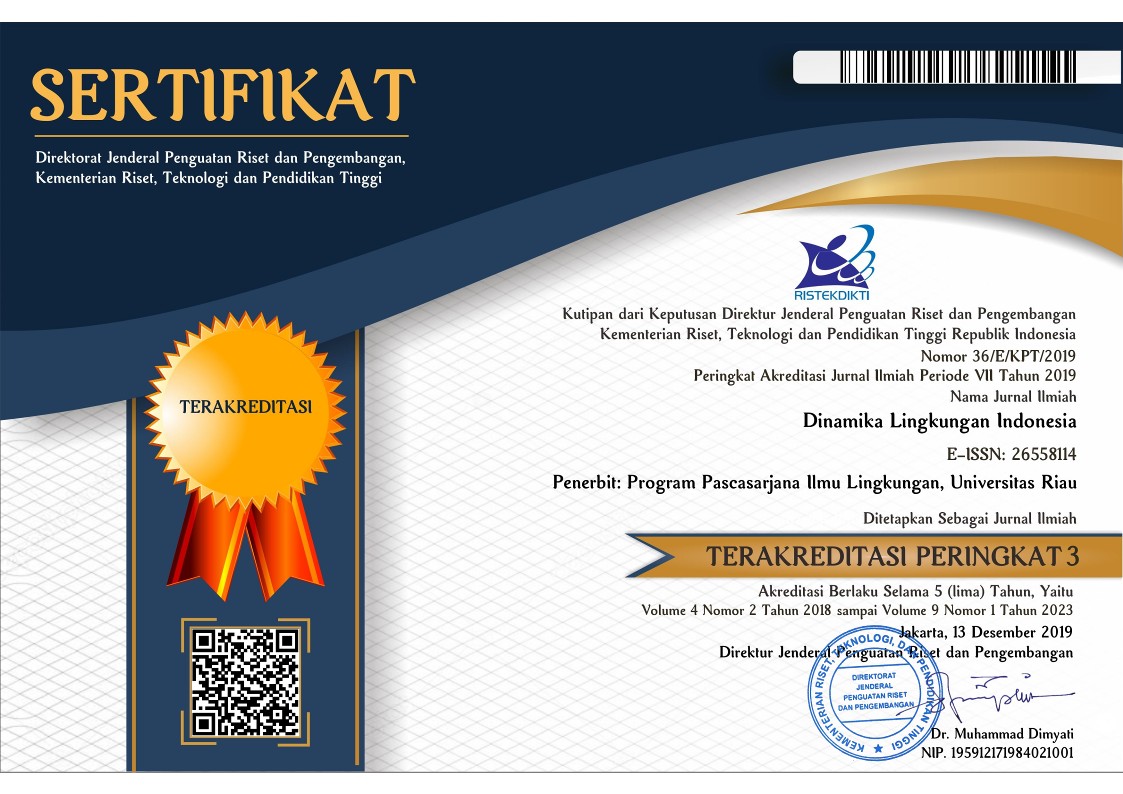Analisis Prospektif Strategi Pengelolaan Kawasan Gambut Secara Berkelanjutan Pasca Kebakaran di Kecamatan Bukit Batu Kabupaten Bengkalis
Abstract
Peat areas have unique characteristics as wetlands on land but are highly flammable if there are El Nino symptoms. The peat area has a protection function and a cultivation function and this is important for the life of living things. To date in 2021, where this research was conducted, the condition of the peat area in Bukit Batu District, Bengkalis Regency is very easy to burn, this requires a sustainable peat area management strategy from the ecological, social, and economic aspects so that fires do not occur in the future. This research can be useful for stakeholders to manage peat areas in a sustainable manner by taking into account the ecological, economic, and social aspects. Repeated fires in the same location make peat even more degraded. For this reason, it is necessary to manage post-fire peat areas, so a management strategy using prospective analysis is needed. The prospective analysis is a method that can be used to find strategies that can be applied in the future. The results of the prospective analysis in this study recommend that there are three strategies that need to be applied, from the ecological aspect, namely the conservation and rehabilitation strategy, from the social aspect, namely the MPA-preneurship strategy and from the economic aspect, namely the strategy of using burned land. These three strategies can be carried out simultaneously and holistically by involving many stakeholders in peat areas.
Keywords
Full Text:
PDFReferences
Bourgeois. (2004). UNESCAP-CAPSA UNESCAP-CAPSA Monographs currently available.
Darsani, Y. S. (2021). Persepsi Petani Terhadap Teknologi “Panca Kelola” Di Lahan Rawa Bekas Terbakar (Kasus Lahan Gambut Bekas Terbakar Desa Talio Hulu Kecamatan Pandih Batu Kabupaten Pulang Pisau, Provinsi Kalimantan Tengah). Angewandte Chemie International Edition, 6(11), 951–952., 46, 10–27.
Daryono, H. (2009). Potensi, permasalahan dan kebijakan yang diperlukan dalam pengelolaan hutan dan lahan rawa gambut secara lestari (71–101).
Godet, M. (2000). The Art of Scenarios and Strategic Planning: Tools and Pitfalls. Technological Forecasting and Social Change, 65(1), 3–22. https://doi.org/10.1016/s0040-1625(99)00120-1.
Gunawan, H., & Afriyanti, D. (2019). Potensi Perhutanan Sosial dalam Meningkatkan Partisipasi Masyarakat dalam Restorasi Gambut. Jurnal Ilmu Kehutanan, 13(2), 227. https://doi.org/10.22146/jik.52442.
Herman. (2017). Pengembangan Industri Perkebunan Sagu Conservation and Restoration Efforts of Peatlands through Sago Industry Development. 54–61.
Irma, W., Gunawan, T., & Suratman, S. (2018). Pengaruh Konversi Lahan Gambut Terhadap Ketahanan Lingkungan di DAS Kampar Provinsi Riau Sumatera. Jurnal Ketahanan Nasional, 24(2), 170. https://doi.org/10.22146/jkn.36679.
Ramdhan, M., & Siregar, Z. A. (2018). Pengelolaan Wilayah Gambut Melalui Pemberdayaan Masyarakat Desa Pesisir Di Kawasan Hidrologis Gambut Sungai Katingan Dan Sungai Mentaya Provinsi Kalimantan Tengah. Jurnal Segara, 14(3), 145–157. https://doi.org/10.15578/segara.v14i3.6416.
Saputra. (2017). Peran kelompoktani dan masyarakat peduli api (MPA) dalam mengelola dan mencegah kebakaran lahan di kecamatan bukit batu kabupaten bengkalis. 19(1), 57–71.
Suwondo, S., Darmadi, D., & Yunus, M. (2018). Perlindungan dan pengelolaan ekosistem: analisis politik ekologi pemanfaatan lahan gambut sebagai hutan tanaman industri. Jurnal Pengelolaan Lingkungan Berkelanjutan (Journal of Environmental Sustainability Management), 2(2), 140–154. https://doi.org/10.36813/jplb.2.2.140-154.
Wikaningrum, T. (2018). Pengelolaan Lingkungan Kawasan Industri ( Studi Kasus Kawasan Industri Jababeka dan EJIP di Kabupaten Bekasi ) Pengelolaan lingkungan kawasan industri masyarakat Indonesia sejalan dengan pertumbuhan industri yang tinggi dan serta Sistem Manajemen Lingkung. Journal of Environmental Engineering & Waste Management (JENV), 3(1), 36–47.
DOI: http://dx.doi.org/10.31258/dli.10.1.p.1-6
Refbacks
- There are currently no refbacks.

This work is licensed under a Creative Commons Attribution 4.0 International License.





